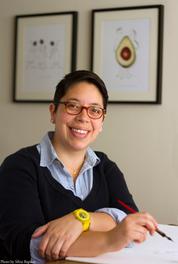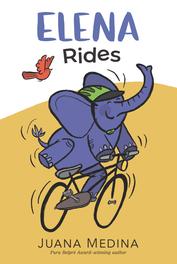 Juana Medina was born and raised in Bogotá, Colombia, and now lives and works in Washington, D.C. She is a graduate of the Rhode Island School of Design and an assistant professor at George Mason University's School of Art. She has written and illustrated picture books, concept books and three chapter books in the Juana & Lucas series, which has been honored by the Pura Belpré Awards and the International Latino Book Awards. Elena Rides (reviewed in this issue) is a beginning reader inspired by Medina's own life. Here she discusses how the story came to be and what it means to her to see it published as a bilingual story.
Juana Medina was born and raised in Bogotá, Colombia, and now lives and works in Washington, D.C. She is a graduate of the Rhode Island School of Design and an assistant professor at George Mason University's School of Art. She has written and illustrated picture books, concept books and three chapter books in the Juana & Lucas series, which has been honored by the Pura Belpré Awards and the International Latino Book Awards. Elena Rides (reviewed in this issue) is a beginning reader inspired by Medina's own life. Here she discusses how the story came to be and what it means to her to see it published as a bilingual story.
Did your twin sons have anything to do with the genesis of this story?
In a way they did. This story came to be after an accident. I slipped and fell, breaking and displacing multiple bones on my spine. After this fall, I had to spend a long time in bed. Eventually, I was able to crawl around the house, slowly regaining movement.
At the time, my sons were shy of turning two years old. Having me crawling around the house meant I was closer to their height; watching them discover the world from a lower perspective than my usual height was extremely powerful. As the twins became nimbler on their feet, I was clumsily regaining my ability to walk. This was a humbling and inspiring process. I couldn't help but feel extremely large and awkward in my movements, and perhaps in an attempt to grasp what I was experiencing, the visual of an elephant riding a bike came to mind. The improbability of a pachyderm successfully learning to ride a bike felt akin to my difficulty regaining my own footing.
I often think of my sons as the little red bird in Elena Rides, lovingly encouraging me to keep going. I'd be remiss to say: the superhero that doesn't appear in the book but kept us afloat throughout this process was my wife. Dealing with a spouse in pain and tiny twin sons wasn't easy, yet she made it seem like a breeze.
Is your creative process different for writing beginning reader books than picture or chapter books?
Chapter books allow for more narrative, texture and detail. I felt that this story was inspired by feelings so complex that it would be best if I was able to distill it to its utmost simplicity. Little ones don't need to hear about my pain or the elephant's pain in detail; they've fallen and failed, and they know how hard it is to try new things again. I felt it was more important to keep the illustrations bold and the text as simple as possible--and to give space for the readers to insert themselves within the story. It was a different process from working on Juana & Lucas. The crafting of the narrative (both prose and visuals) has often felt like weaving a tapestry, whereas on Elena Rides it was more sound-driven and at a much faster beat. I relied on repetition and simple phrasing to keep the text upbeat and accessible.
In a way, my biggest dream with this book is for beginning readers to learn to read while Elena learns to ride her bike. They might stumble a bit in the process, but eventually they'll enjoy their new skills as much as this peculiar elephant enjoys riding. I hope the upbeat pace and repetition make the process of learning to read pleasurable--less of a task and more an empowering activity.
 The palette in Elena Rides is bright and eye-catching. How did you decide on the deep purple and vivid mustard colors?
The palette in Elena Rides is bright and eye-catching. How did you decide on the deep purple and vivid mustard colors?
I thought of this book while living in Oaxaca, Mexico. The understanding of color in this region of Mexico is something absolutely extraordinary. Artisans have been working traditionally with dyes, paints and fibers for centuries. Their understanding of color is in their DNA, and it shows in the architecture, textiles, furniture--even food. Meanwhile, my understanding of color is rather limited. The year I spent in Oaxaca was like living enveloped in the most delicious explosion of color.
I borrowed the mustard yellow from the golden clouds of dust that rise in the dry Oaxacan summers and the purple, from the jacaranda blooms. I increased the saturation because I wanted further contrast and boldness. I am in debt to the Oaxacans who came to the rescue when I fell. They treated my family like part of the community, despite the fact that we'd only been there for mere weeks before my accident. These became small ways in which I could honor a place that offered us a sense of home when we most needed it.
Do you remember the ups and downs of learning to ride a bike as a child?
Very much so! I learned to ride using my cousin's buttermilk-yellow bike. It had a fabulous Ghostbusters sticker on the head tube, which made it the coolest ride in all of Bogotá in 1986--at least for my cousin Felipe and for me.
The seat would often slide backwards--I don't even understand how or why a parent didn't step in with a wrench to fix this but, hey, it was the '80s!--which made it rather unsafe. But this only gave it an extra element of risk that made an unusual sense of bravado kick in. Needless to say, I didn't just learn to ride but to ride standing on my feet to avoid getting hurt.
Riding a bike (despite the inevitable falls) is one of my best memories from childhood. The sense of freedom and thrill that came along with pedaling is unforgettable. I very much relate it to the sense of thrill and freedom that came with learning to read and write.
How much fun was it to devise and vary the moments of onomatopoeia in the book?
It was truly fun! There's something about writing in a second language (Spanish is my mother tongue) that has always made me savor some words and their funny sounds in a way that one doesn't often question with a first language. This is not unlike children do when learning new words, as I observe in my six-year-old twins.
It was fun to think of language in a way that could lead the story in a more sonic way, rather than being heavily prose-driven.
A dual-language (Spanish/English) edition of this title, Elena Rides/Elena monta en bici, will be released simultaneously--what does that mean to you?
Having the privilege of writing a version of the book in Spanish has been something extraordinary. It was delightful to do this in the good guidance of editor Melanie Cordova, with support from a team of fellow Spanish-speakers at Candlewick Press (¡Hola, Juan Botero y Alex Robertson!) and Iraida Iturralde's translation expertise.
There is something absolutely indescribable about accessing my work in Spanish. I've discovered with time how the nostalgia and longing I, as an immigrant, often feel for home is soothed by sharing stories in the language of my childhood. The dual-language edition makes me giggle with excitement! It's a wonderful way to celebrate 20 years (as of 2022) of my immigrant journey by accessing in between the covers of one book the two languages that have shaped my world as a reader and writer.
It is strange how powerful the experience of creating a book can be. This book in its dual edition has offered me a deeper sense of belonging, an unexpected and welcome gift. I hope this version helps bring that same feeling of belonging to young readers and their families--as well as a chance to learn a new language! --Julie Danielson, reviewer and copyeditor

